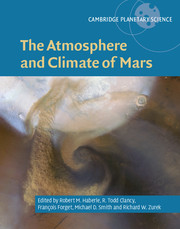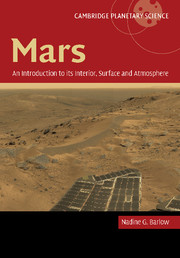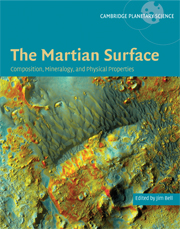The Atmosphere and Climate of Mars
Humanity has long been fascinated by the planet Mars. Was its climate ever conducive to life? What is the atmosphere like today and why did it change so dramatically over time? Eleven spacecraft have successfully flown to Mars since the Viking mission of the 1970s and early 1980s. These orbiters, landers and rovers have generated vast amounts of data that now span a Martian decade (roughly eighteen years). This new volume brings together the many new ideas about the atmosphere and climate system that have emerged, including the complex interplay of the volatile and dust cycles, the atmosphere-surface interactions that connect them over time, and the diversity of the planet's environment and its complex history. Including tutorials and explanations of complicated ideas, students, researchers and non-specialists alike are able to use this resource to gain a thorough and up-to-date understanding of this most Earth-like of planetary neighbours.
- Emphasizes the physical processes while capturing how knowledge has changed as a result of data from space exploration
- Covers all aspects of the atmosphere and climate system, and will appeal to atmospheric scientists of many different specialties
- Examines the many developments, observations and model improvements in the field of Mars exploration since the topic was last reviewed in 1992
Reviews & endorsements
'It has become clear that understanding the Martian atmosphere will be as complex a challenge as comprehending Earth’s. This volume contains chapters exploring the observation history, energy budget, clouds, boundary layer, mesoscale meteorology, global circulation, photochemistry, and ionosphere, as well as the planet's dust, water, and carbon dioxide cycles. Additional chapters examine Mars's fascinating climate history, ranging from planetary formation to the most recent centuries. Most interesting to non-specialists may be the climate history, which suggests Mars once resembled Earth with a thick atmosphere, abundant precipitation and ground water, and possibly an ocean. For this reason, early Mars was presumably friendlier to possible life than the frigid, desiccated surface - with atmospheric pressure less than 1 percent of Earth's - that we see now. … Recommended. Upper-division undergraduate students through faculty.' M. K. Cleaveland, Choice
Product details
August 2017Hardback
9781107016187
588 pages
282 × 227 × 32 mm
1.91kg
298 b/w illus. 29 tables
Available
Table of Contents
- 1. Introduction Robert M. Haberle, R. Todd Clancy, François Forget, Michael D. Smith and Richard W. Zurek
- 2. Understanding Mars and its atmosphere Richard W. Zurek
- 3. History of Mars atmosphere observations Philip B. James, Philip R. Christensen, R. Todd Clancy, Mark T. Lemmon and Paul Withers
- 4. Thermal structure and composition Michael D. Smith, Stephen Bougher, Thérèse Encrenaz, François Forget and Armin Kleinböhl
- 5. Mars clouds R. Todd Clancy, Franck Montmessin, Jennifer Benson, Frank Daerden, Anthony Colaprete and Michael J. Wolff
- 6. Radiative process: techniques and applications Michael J. Wolff, Miguel Lopéz-Valverde, Jean-Baptiste Madeleine, R. John Wilson, Michael D. Smith, Thierry Fouchet and Gregory T. Delory
- 7. The Martian planetary boundary layer Peter L. Read, Boris Galperin, Søren E. Larsen, Stephen R. Lewis, Anni Määttänen, Arakel Petrosyan, Nilton Renno, Hannu Savijärvi, Tero Siili, Aymeric Spiga, Anthony Toigo and Luis Vázquez
- 8. Mesoscale meteorology Scot C. R. Rafkin, Aymeric Spiga and Timothy I. Michaels
- 9. The global circulation Jeffrey R. Barnes, Robert M. Haberle, R. John Wilson, Stephen R. Lewis, James R. Murphy and Peter L. Read
- 10. The Mars dust cycle Melinda A. Kahre, James R. Murphy, Claire E. Newman, R. John Wilson, Bruce A. Cantor, Mark T. Lemmon and Michael J. Wolff
- 11. The water cycle Frank Montmessin, Michael D. Smith, Yves Langevin, Michael T. Mellon and Anna Federova
- 12. The CO2 cycle Timothy N. Titus, Shane Byrne, Anthony Colaprete, François Forget, Timothy I. Michaels and Thomas H. Prettyman
- 13. Atmospheric photochemistry Franck Lefèvre and Vladimir Krasnoplosky
- 14. Upper neutral atmosphere and ionosphere Stephen W. Bougher, David A. Brain, Jane L. Fox, Francisco Gonzalez-Galindo, C. Simon-Welund and Paul Withers
- 15. Solar wind interaction and atmospheric escape David A. Brain, Sergey Barabash, Stephen W. Bougher, Firat Duru, Bruce M. Jakosky and Ronan Modolo
- 16. Recent climate variations François Forget, Shane Byrne, James W. Head, Michael A. Mischna and Norbert Schörghofer
- 17. The early Mars climate system Robert M. Haberle, David C. Catling, Michael H. Carr and Kevin J. Zahnle
- 18. Future prospects Robert M. Haberle, Todd Clancy, François Forget, Michael D. Smith and Richard W. Zurek
- Index.





